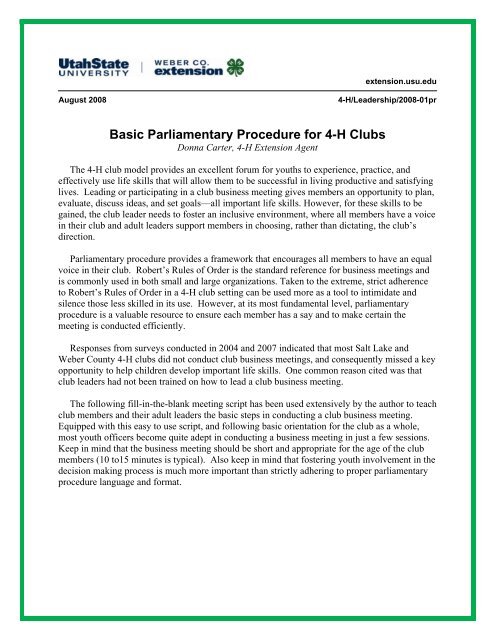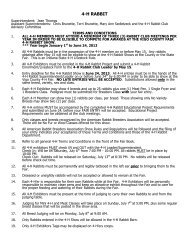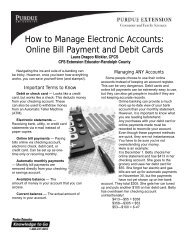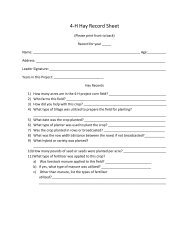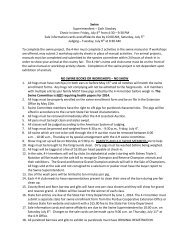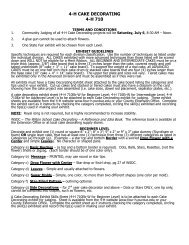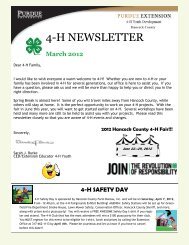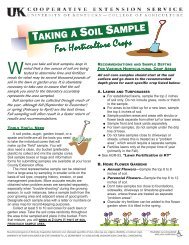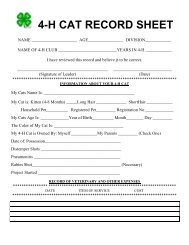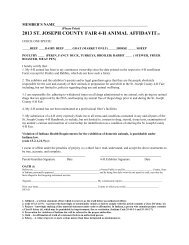Basic Parliamentary Procedure for 4-H Clubs - Utah State University ...
Basic Parliamentary Procedure for 4-H Clubs - Utah State University ...
Basic Parliamentary Procedure for 4-H Clubs - Utah State University ...
- No tags were found...
Create successful ePaper yourself
Turn your PDF publications into a flip-book with our unique Google optimized e-Paper software.
<strong>Basic</strong> <strong>Parliamentary</strong> <strong>Procedure</strong> TermsAgendaAyeFloorMajorityMotionNay<strong>Parliamentary</strong><strong>Procedure</strong>Presiding OfficerSecondThe order of the business meeting. The typical order <strong>for</strong> a 4-H meetingis:• Call to Order• Pledges• Welcome Guests• Roll Call• Minutes• Treasurer’s Report• Committee Reports• Old Business• New Business• Announcements• Adjourn Business Meeting• Educational Program or Project Experience• Social Time (Songs, Games and/or Refreshments)When a vote is called, the members who agree with the motion will say,“Aye.”Only one person is allowed to speak at a time during the meeting. Theperson who has been given permission to speak by the presiding officer“has the floor” or the right to speak. To obtain the floor, a memberraises their hand and the presiding officer will call on that member.One more than half of the voting members. This is the minimumnumber of votes needed to pass most motions.A suggestion that a member wants the group to consider. A motion isstated in the <strong>for</strong>m, “I move that …”When a vote is called, the members who disagree with the motion willsay, “Nay.”A set of guidelines that describes the proper way to conduct a businessmeeting.The person in charge of conducting the business meeting, typically thepresident or the chairperson.Once a motion has been made, the president will ask <strong>for</strong> a “second.”This is like asking if there is another member who agrees that the groupshould consider the suggestion. To second a motion a member will say,“I second that motion” or “Second.”2
A motion is an idea or a suggestion that a member or committee wants the group to consider. Inmost instances, there are five steps in bringing a motion to the floor and having it voted upon bythe group.Five Steps of a MotionSteps1. A member makes amotion.2. Another memberseconds that motion.3. The presiding officerstates the motion and itis discussed.Who SpeaksAfter being recognized bythe presiding officer.Any MemberAny Other MemberPresiding OfficerMember 1Member 2Member 3Member 4Presiding OfficerWhat Is SaidIn this example the club is considering participating in aparade.“I move that our club enters a float in thisyear’s Thanksgiving parade.”“I second that motion.”“It has been moved and properly secondedthat our club enters a float in this year’sThanksgiving parade. Is there anydiscussion?”“I think this would be a great way topromote 4-H.”“In the past my grandfather has beenwilling to let our club use his trailer <strong>for</strong> thefloat. I would be willing to ask him again.”“We still have lots of supplies left overfrom last year’s float, so it would not cost alot of money to make a float.”“I don’t think we have enough time to get afloat ready <strong>for</strong> the parade.”“Is there any further discussion?”4. A vote is taken. A voicevote is most commonlyused; however, a votecan also be taken by ashow of hands, standingup, or by ballot.5. The outcome isannounced.Presiding OfficerPresiding Officer“All in favor say ‘Aye’. All opposed say‘Nay’.”“The motion carries. Our club will enter afloat in this year’s Thanksgiving parade.”3
Teaching youth officers to lead a business meeting is quite easy by providing them with a basicscript that explains what to say and what to do, such as the one below.CALL TO ORDERSample Business Meeting Script <strong>for</strong> a 4-H ClubPresident Taps gavel. “The meeting of the 4-H Club willplease come to order.”PLEDGESPresident “Will and ___________ please come <strong>for</strong>ward and lead usin our Pledge of Allegiance and 4-H Pledge?” The president asks twomembers to lead pledges be<strong>for</strong>e the meeting begins.Any MemberAny Member“Please stand and join me in reciting the Pledge of Allegiance.”Member leads pledge.“Please remain standing and join me in reciting the 4-H Pledge.”Member leads 4-H Pledge. “You may be seated.”INTRODUCE NEW MEMBERS/GUESTSVice President(or other officer assignedthis responsibility)“We are pleased to introduce ______________ who is a (new member,guest, etc.) to our club. Thank you <strong>for</strong> joining us.” It would be great <strong>for</strong>the vice president to meet any new members or guests prior to themeeting and learn a little bit of in<strong>for</strong>mation about them to make theirintroduction to the group more special.ROLL CALLPresidentSecretary“The secretary will now call roll.”Calls roll and records attendance.READING OF THE MINUTESPresidentSecretaryPresident“The secretary will read the minutes of the last meeting.”Reads the minutes from the last meeting.“Are there any corrections or additions to the minutes?” PAUSE. If amember notices a mistake, the member will raise his hand. When calledon by the president, he or she will explain the mistake.IF CORRECTIONS: “The secretary will please make the correction.Are there any other corrections or additions?” PAUSE. “If not, the4
TREASURER’S REPORTminutes stand approved as corrected.”IF NO CORRECTIONS: “If not, the minutes stand approved as read.”PresidentTreasurerPresident“Will the treasurer give the treasurer’s report?”Reports on the balance on hand and explains any money paid out orreceived since the last club business meeting.“Are there any questions regarding the treasurer's report?” PAUSE. Ifa member has a question about the report, he or she will raise his/herhand, and when recognized by the president, will ask the question.If questions: The treasurer will answer any questions about the report.After all questions have been answered say, “If there are no furtherquestions, the treasurer’s report will be filed <strong>for</strong> audit.”If no questions: “If not, the treasurer’s report will be filed <strong>for</strong> audit.”COMMITTEE REPORTSCommitteeChairpersonCommittees are small groups that have been appointed or elected todiscuss or investigate a specific topic and make a recommendation tothe group. Some of the committees your 4-H club might have are:activity committee, community service committee, fund raisingcommittee, parade committee, etc. Committee chairman should reportback to the club to in<strong>for</strong>m them of what their committee has beenworking on and their suggestions <strong>for</strong> the club. The club may have tovote on something that the committee suggests.OLD BUSINESSPresidentAs the agenda is prepared be<strong>for</strong>e the meeting, the president will refer tothe minutes of the last meeting to list unfinished business, which isbusiness that was discussed at a previous meeting that still hasunfinished details or decisions to be made.“Our first item of unfinished business is...” The president, leader, oranother member will help lead the discussion about each business item.Who will lead the discussion is generally identified on the agenda.5
NEW BUSINESSPresidentAs the agenda is prepared be<strong>for</strong>e the meeting, the president or leaderwill identify new issues <strong>for</strong> the club to discuss.“Our first item of new business is...” The president, leader or anothermember will help lead the discussion about each business item. Whowill lead the discussion is generally identified on the agenda. If adecision needs to be made <strong>for</strong> any business item, the president willaccept a motion from the floor and a vote will be held.PresidentAny MemberPresidentAny MemberPresidentAny MemberPresidentAfter all listed new business listed on the agenda has been discussed, “Isthere any other new business to bring be<strong>for</strong>e the club?”After receiving the floor from the president, any member may bring upnew business. If the business requires a decision to be made, themember will say, “I move that…”“Is there a second to this motion?”“I second that motion.”“The motion has been made and properly seconded to ______________.Is there any discussion?”Any member may raise their hand and share their views about the issuewhen the president calls on them.“If there is no further discussion, then we will vote. All in favor say‘Aye.’ All opposed ‘Nay’.” The motion carries (or fails depending ofthe vote).”ANNOUNCEMENTSPresidentYour club leader may prepare a list of announcements or prepare atake-home list <strong>for</strong> each member with important dates and reminders.“Here is a list of announcements and reminders” or “Are there anyannouncements?”Any MemberAfter receiving the floor from the president, any member or leader maymake announcements.ADJOURNMENT OF BUSINESS MEETINGPresident“If there is no further business, is there a motion that we adjourn thebusiness meeting?”6
Any MemberPresidentRaises hand. After receiving the floor from the president the memberwill say, “I move that this meeting be adjourned.” This particularmotion does not need a second.“This meeting is adjourned.”This concludes the business portion of the 4-H club meeting, which is typically followed byeducational activities, then social activities and refreshments. By incorporating a youth ledbusiness meeting into each 4-H club meeting and equipping members with the basic skillsneeded to actively participate in making decisions, children gain valuable life skills. They learnto plan and make sound decisions, improve their public speaking skills, and take greaterownership of their club.Resources:Hendricks, Patricia A. (1996). Developing Youth Curriculum Using the Targeting Life SkillsModel. Iowa <strong>State</strong> <strong>University</strong> Extension.Robert III, Henry M. (2000). Robert’s Rules of Order Newly Revised, 10 th edition.<strong>Utah</strong> <strong>State</strong> <strong>University</strong> is committed to providing an environment free from harassment and other <strong>for</strong>ms ofillegal discrimination based on race, color, religion, sex, national origin, age (40 and older), disability, and veteran’sstatus. USU’s policy also prohibits discrimination on the basis of sexual orientation in employment and academicrelated practices and decisions.<strong>Utah</strong> <strong>State</strong> <strong>University</strong> employees and students cannot, because of race, color, religion, sex, national origin, age,disability, or veteran’s status, refuse to hire; discharge; promote; demote; terminate; discriminate in compensation;or discriminate regarding terms, privileges, or conditions of employment, against any person otherwise qualified.Employees and students also cannot discriminate in the classroom, residence halls, or in on/off campus, USUsponsoredevents and activities.This publication is issued in furtherance of Cooperative Extension work. Acts of May 8 and June 30, 1914,in cooperation with the U.S. Department of Agriculture, Noelle E. Cockett, Vice President <strong>for</strong> Extension andAgriculture, <strong>Utah</strong> <strong>State</strong> <strong>University</strong>.7


